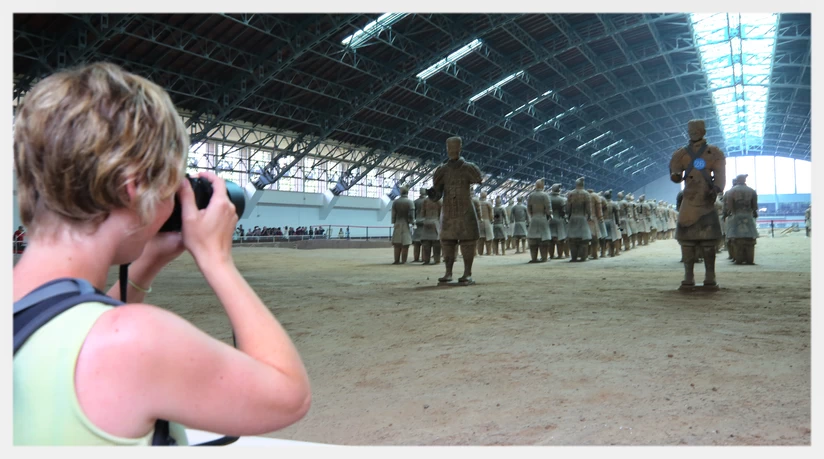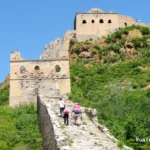Plan your Xi’an Tour? Welcome to your “How to Visit Terracotta Warriors” guide to plan a trip to the Terracotta Warriors in Xi’an, China. This guide is specifically crafted for foreign tourists eager to explore this remarkable historical site.
We will cover everything you need to know, from how to get there to what to expect during your visit. Let’s dive in!
1. Why Visit the Terracotta Warriors?
The Terracotta Warriors are one of China’s most significant archaeological discoveries. Found near Xi’an, this ancient army of life-sized soldiers was buried with Emperor Qin Shi Huang to protect him in the afterlife. The site includes over 8,000 soldiers, horses, and chariots, each with unique features.
The Terracotta Warriors were discovered in 1974 by local farmers digging a well. This accidental discovery led to one of the most significant archaeological finds of the 20th century. Excavations have since revealed thousands of warriors, each uniquely crafted with distinct features.
Visiting the Terracotta Warriors offers a glimpse into ancient Chinese history and craftsmanship. Here are some reasons to visit:
- Historical Significance: The Terracotta Army dates back to the third century BCE.
- Unique Craftsmanship: Each figure is uniquely crafted with detailed features.
- Cultural Experience: It provides a deep insight into Chinese burial practices and beliefs.
2. Best Time to Visit Terracotta Warriors
When planning your visit, consider Xi’an’s climate and tourist seasons. Spring and autumn offer mild temperatures, making them ideal times for your trip. However, it’s best to avoid Chinese national holidays, as the site becomes particularly crowded.
Best Time to Visit
- Spring (March to May): The weather is warm, ideal for outdoor activities, and there are relatively fewer tourists, allowing for a more enjoyable experience.
- Autumn (September to November): The weather is cool, with fewer tourists, making it a great time to avoid peak travel seasons.
Although the Terracotta Army Museum is an indoor attraction, accessible throughout the year, the number of visitors tends to peak during weekends and public holidays like the National Day Holiday (October 1–7) and Labor Day Holiday (May 1–3). Winter visits offer a quieter experience, albeit with colder weather.
3. How to Get to Terracotta Warriors from Xi’an
Located 40 km northeast of downtown Xi’an city, the Terracotta Army is easily accessible. To get to the Terracotta Warriors (Terracotta Army Museum) from Xi’an, you have several options:

Three Major Travel Routes from Xi’an to the Terracotta Warriors
1. By Train + Taxi or Didi (50 minutes)
Take a train from Xi’an Railway Station to Lintong Railway Station (临潼火车站), which takes about 20 minutes and costs between 5 and 10 yuan. From Lintong Station, you can take a Didi or a taxi directly to the Terracotta Warriors Museum, costing around 20 yuan.
This route is the fastest, taking approximately 50 minutes in total. However, the downside is that you need to arrive at the train station in advance, and train times are limited.
2. By Metro + Bus (1.5 hours)
Start from Zhonglou Metro Station (Bell Tower Station 钟楼地铁站), take Metro Line 6, transfer to Line 9, and get off at Huaqingchi Metro Station(Huanqing Hot Spring Station 华清池地铁站). This journey takes about 55 minutes and costs 7 yuan.
From there, take Bus 602 or 613 directly to the Terracotta Warriors Museum, which takes about 25 minutes and costs between 2 and 5 yuan. Bus 613 has a high frequency, so you usually won’t have to wait long. This option is convenient and affordable but takes about 1.5 hours in total and requires several transfers.
3. By Direct Bus (1 hour)
You can buy tickets online or at the departure points, costing 30 yuan. Departure points include the Vienna Hotel 维也纳大酒店大雁塔店(Giant Wild Goose Pagoda branch) parking lot, outside the Yisu Grand Theatre 易俗社大剧院门口 钟楼附近 (near the Bell Tower), outside the City Library (市图书馆), and Sajin Bridge Metro Entrance (洒金桥地铁口).
This bus route goes directly to the Terracotta Warriors without needing transfers, making it suitable for those traveling with elderly people or children. The downside is that buses depart early in the morning and may require waiting for the bus to fill up before departure.
These three major routes offer different advantages and disadvantages for self-guide tourists, so you can choose according to your personal needs and preferences.
Taxi/Mobile Apps
Taxis are readily available in Xi’an, and you can use popular ride-hailing apps like Didi for convenience. Negotiate a fare with the driver or use the meter to reach the Terracotta Warriors.
The distance is around 40 kilometers from downtown Xi’an, and the journey takes approximately 1-1.5 hours, depending on traffic. Taxi fare: approx. 150 yuan, plus toll fee: 20 yuan.
Private Car
If you prefer a more private and flexible option, you can hire a car with a driver for the day or part of the day. This option allows you to visit other attractions around Xi’an at your own pace and convenience. Many hotels in Xi’an can assist you in arranging private car services.
4. Decide the Visiting Time in the Museum
First determine the number of days you want to spend in Xi’an. Consider other attractions you may want to visit in addition to the Terracotta Warriors.
he time needed to visit the Terracotta Warriors varies based on your interests and tour style.
Suggested Visiting Times
- Main Exhibit: To see Pits 1, 2, and 3 in detail, plan for about 3 to 4 hours. This excludes other museum exhibits.
- Quick Tour: For a brief look at Pits 1 and 2, about 2 hours is enough.
- In-depth Tour: If you want to fully explore the history and background of each statue, set aside half a day or more.
Touring Tips
- Detailed Tour: Reserve at least half a day to grasp the historical context, craftsmanship, and artifacts on display.
- Time by Pit:
- Pit 1: About 1 hour.
- Pit 2: Around 30 minutes.
- Pit 3: Around 20 minutes.
- Other Museum Exhibits: The museum also has exhibits on the warriors’ history and craftsmanship. Plan about 30 minutes here to watch videos and explore artifacts in depth.
This should help you enjoy a well-paced visit!
5. Book your Tickets Online
The Terracotta Warriors Museum requires advance online ticket booking, either through their official website or WeChat account. Check opening hours and plan to arrive early for a leisurely visit.
Please check out How to Book Terracotta Warriors Tickets for more detailed information.
Opening Hours and Entrance Fees
Ticket Selling Hours:
8:30 – 17:00 (March 16 – Nov 15)
8:30 – 16:30 (Nov 16 – March 15)
Opening Hours
8:30 – 18:00 (March 16 – Nov 15)
8:30 – 17:30 (Nov 16 – March 15)
Entrance Fees
RMB 120 ( all year round) /person
The ticket also includes the entrance to Qin Shihuang’ Mausoleum.
Note:
1) the Terracotta Warriors Museum is open all year round – 365 days every year! Children under the height of 1.2m are free of charge.
2) Don’t confuse the Terracotta Army Museum with Qin Shihuang’s Mausoleum. Your ticket includes entrance to both, but the mausoleum is less excavated, not much to see.
How to Book your Ticket to Terracotta Army
- Book your ticket through the museum’s official Terracotta Army Ticketing Page
- Through the Viator ( Easiest for English users ): 👉 Book Tickets + Shttle Bus Now!
- Booking Phone Number: 029-81399127
- On-site Ticket booking is all right.
Note: There is a cap for the number of visitors during holidays. But basically, you won’t have any problem buying your tickets if you avoid visiting the site during National Holiday (Oct 01 -07).
6. How to Visit Terracotta Warriors
While planning a Trip to Terracotta Warriors, you should know visiting the Terracotta Warriors can be overwhelming due to its size and popularity.
Firstly, arriving early helps you avoid the crowds and enjoy a more peaceful experience. The site opens at 8:30 AM, so aim to arrive by then.
Kindly Reminder:
It is a long walk from the main entrance to the three pits site! If you don’t have strong legs, you may pay small money to take an electric car from the museum to get there.
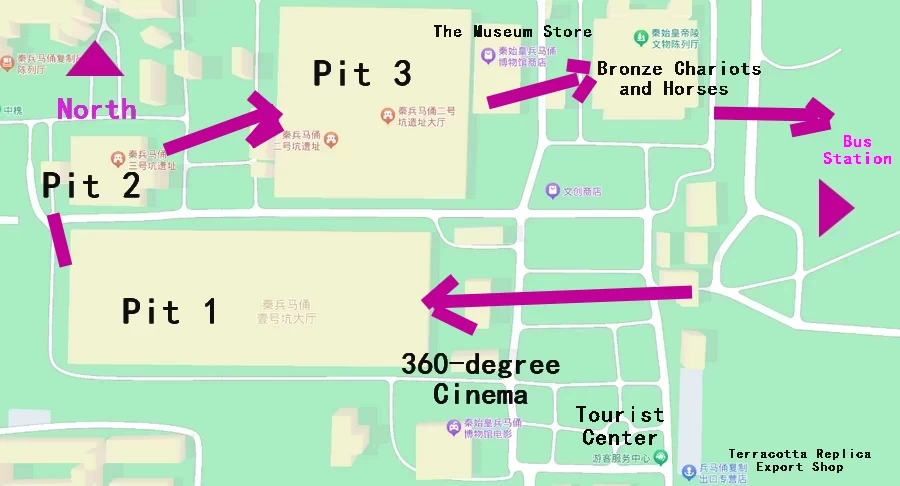
The Terracotta Warriors are divided into three pits. Start with Pit 1, which is the largest and the most impressive. Then move on to Pits 2 and 3, which have fewer crowds.
Start with Pit 1
Most visitors begin their visit with Pit 1, the largest and most impressive pit. Once inside, you’ll see rows of life-sized terracotta soldiers, chariots, and horses.
Pit 1 is the largest and most impressive of the three pits at the Terracotta Warriors site. It houses over 6,000 life-sized soldiers, horses, and chariots arranged in battle formation.
Discovered first in 1974, it covers an area of 14,260 square meters. The warriors face east, ready to protect Emperor Qin Shi Huang in the afterlife.
Each figure is uniquely crafted with detailed expressions and armor. This pit provides a breathtaking view of the sheer scale and organization of the ancient army. Visitors can walk along raised walkways to get a closer look at the rows of warriors.
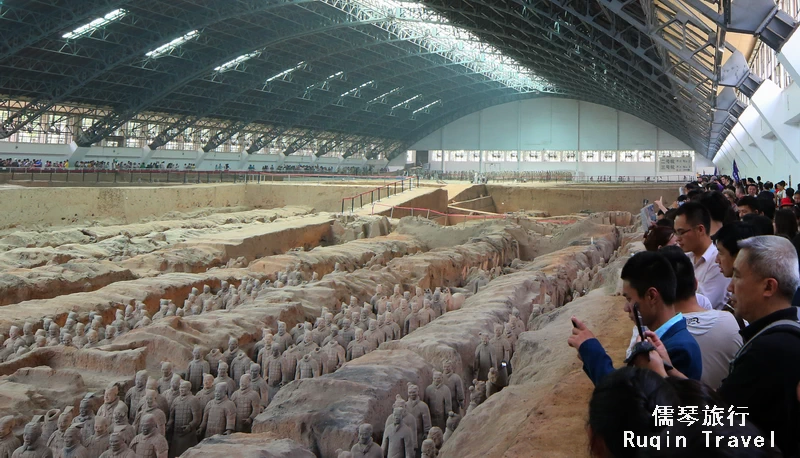
Proceed to Pit 2
After exploring Pit 1, proceed to Pit 2. Pit 2 is smaller but equally fascinating. It contains a variety of military units, including archers, cavalry, and infantry.
This pit offers a more diverse display of the Qin army’s different tactical formations. Covering about 6,000 square meters, Pit 2 was discovered in 1976. The figures in this pit are more intricately arranged, showcasing the strategic and combat skills of the ancient army.
Visitors can see figures in action poses, holding weapons, and preparing for battle. This pit also features some of the best-preserved artifacts, including bronze weapons and tools.
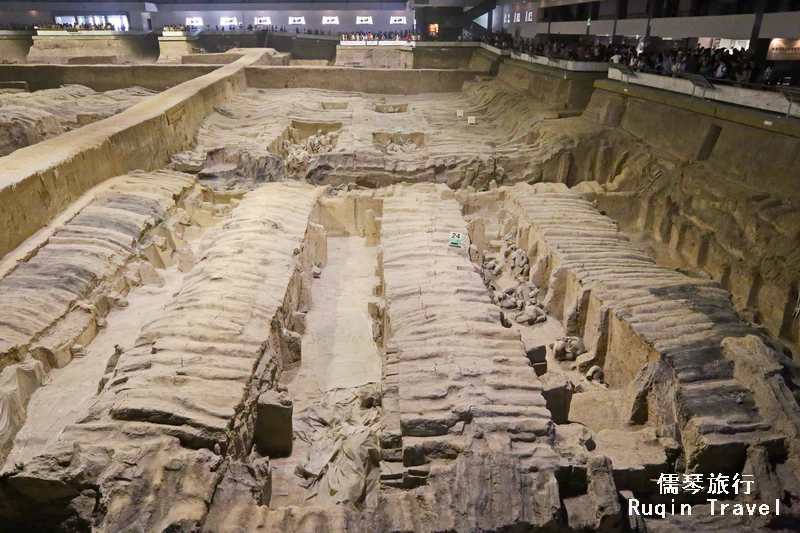
Pit 3
Pit 3 is the smallest and serves as the command center of the Terracotta Army. Covering an area of 520 square meters, it was discovered in 1976.
This pit contains high-ranking officers and war chariots. Unlike the other pits, Pit 3 has fewer figures, with only about 68 warriors. However, it holds great significance due to its strategic role.
The arrangement suggests it was used for military planning and command. Visitors can observe the detailed features of the officers, their uniforms, and their unique positions. Pit 3 provides insight into the hierarchical structure and command system of the ancient army.
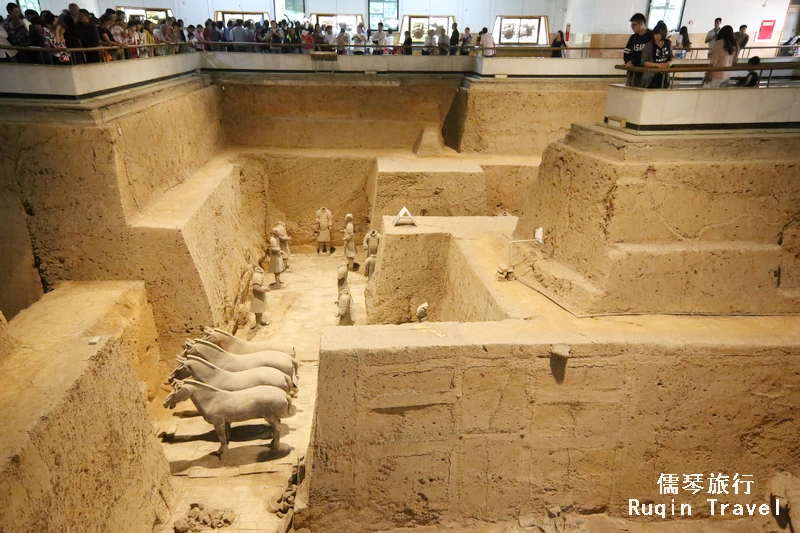
The Average Height of the Terracotta Warriors
The average height of the Terracotta Warriors is about 1.8 meters (5.9 feet). However, the heights vary slightly to reflect the rank and role of each figure. Higher-ranking officers are generally taller than the soldiers, adding to the realism of the army.
Visit the Exhibition Halls (Bronze Chariots and Horses)
In addition to the three main pits, the Terracotta Army Museum features several exhibition halls. These halls house various artifacts, including bronze weapons, ancient pottery, and other archaeological discoveries. Take your time to explore these halls and learn more about the history and significance of the site.
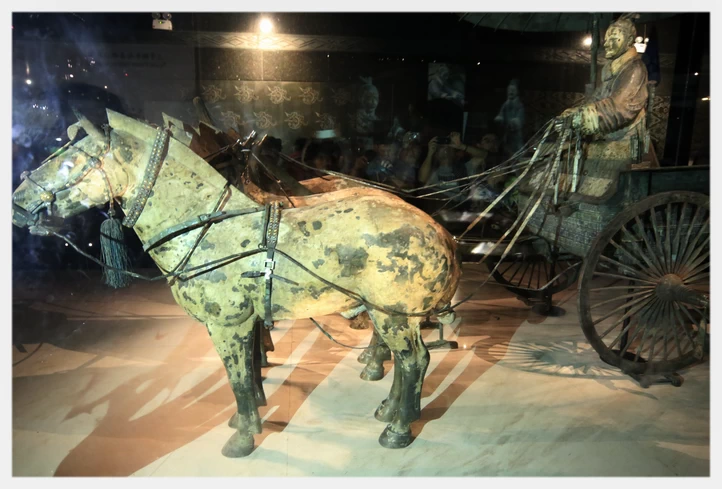
The most important is that there are two world-famous bronze chariots and horses whose sizes are about a half of that of real chariots and horses. So the official name of the museum is called Terracotta Warriors and Horses Museum.
A 360-degree cinema
The site offers additional attractions and activities, such as a 360-degree cinema that presents the history and discovery of the Terracotta Warriors.
The movie -360 degrees, the background film, is in English and very cool, which takes about 15 minutes long. It gives some background to what you see with your own eyes.
Guided Tours and Audio Guides
Guided tours and audio guides are available at the Terracotta Warriors site. They provide detailed information about the history, significance, and unique features of the site.
Opting for a guided tour can enhance your understanding and appreciation of this incredible archaeological wonder.
Shopping for Souvenirs
There are several souvenir shops at the Terracotta Warriors Museum. Popular items include miniature terracotta figures, books, postcards, and traditional Chinese crafts. Make sure to buy from reputable shops to ensure the quality and authenticity of the items.
Preservation Efforts
You will see the Terracotta Warriors preserving efforts is still going on. Exposure to air and light can cause deterioration. Therefore, significant efforts are made to protect and conserve these ancient artifacts. Advanced technologies are used to stabilize the figures and prevent further damage.
7. Wheelchair users Visiting the Terracotta Warriors
Wheelchair users visiting the Terracotta Warriors will find several facilities to ensure an accessible and comfortable experience. The Museum of the Terracotta Warriors and Horses of Qin Shi Huang offers free wheelchair rentals at the Tourist Service Center.
Additionally, the site features multiple accessible restrooms and ramps for easy navigation. Volunteers are available periodically for assistance, and staff at the service center can provide further support and information.
The museum’s layout is designed to accommodate wheelchair users, allowing them to explore the pits and exhibition halls with ease.
8. Service Facilities at the Museum
Parking
- Parking Lot: [Terracotta Warriors Parking Lot]
- Reference Price: 20 RMB per time
- Address: Near Qinling North Road, Lintong District, Xi’an, Shaanxi Province
- Capacity: 500 spaces
Mobile Charging
- Location: The Tourist Service Center at the Museum of the Terracotta Warriors is equipped with charging power outlets.
Luggage Storage
- Reference Price: Please consult the on-site staff.
- Address: Luggage storage is located east of the ticketing center.
Tour Guide Services
- Location: The Tourist Center at the Museum of the Terracotta Warriors
- Services Offered: Electronic guide services and expert appointment explanation services.
- Details: Professional explanation services available in Chinese, English, and Japanese. Expert appointment explanation services are available. Free broadcast search services are offered. Volunteers provide free consultation services periodically.
Stroller Rental
- Reference Price: Free
- Location: Tourist Service Center
Wheelchair Rental
- Reference Price: Free
- Location: Tourist Service Center
Restrooms
- Location: The Museum of the Terracotta Warriors has multiple restrooms. There are five restrooms inside the museum and five in Lishan Garden. You can choose to use them according to the guide signs.
Smoking Area
- Location: There are several smoking areas within the scenic area.
ATM
- Location: To the right of the main entrance at the Tourist Service Center
Dining
- Cost: Charged
- Location: There is a buffet inside the scenic area.
Vending Machines
- Location: Tourist Service Center
Convenience Stores
- Location: There are several convenience stores at the entrance and within the scenic area.
Visiting the Terracotta Warriors in Xi’an is a once-in-a-lifetime experience that offers a deep dive into China’s rich history. With this “Plan a Trip to Terracotta Warriors” guide, you are now equipped with all the information needed to plan a smooth and enjoyable trip. From how to get there to what to expect, every detail has been covered to ensure you have an unforgettable visit.
By following these tips and guidelines, your trip to the Terracotta Warriors in Xi’an will be smooth and enjoyable. Remember to plan ahead, pack appropriately, and respect this significant historical site. Happy travels!
More Xi’an Travel Guides
Planning your Xi’an Tour? Our ” Xi’an Travel Guide” section offers essential advice to help you navigate the city like a pro. From transportation tips and local customs to insider recommendations for hidden gems, these travel tips will ensure you have a smooth, enjoyable, and unforgettable experience in China’s vibrant capital. Let us guide you through the best practices for exploring Xi’an with confidence!

